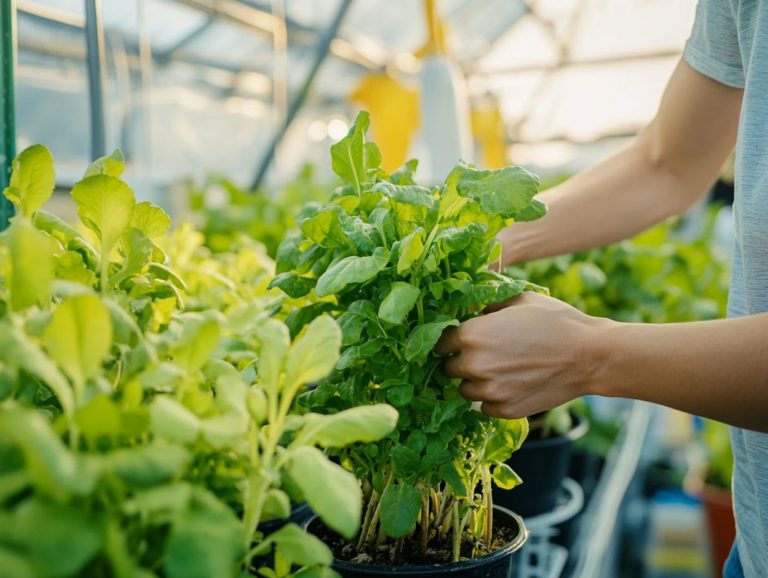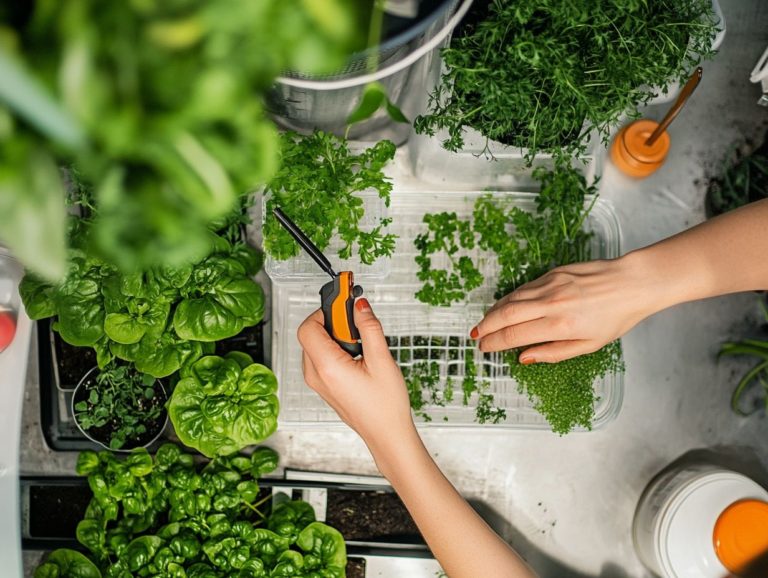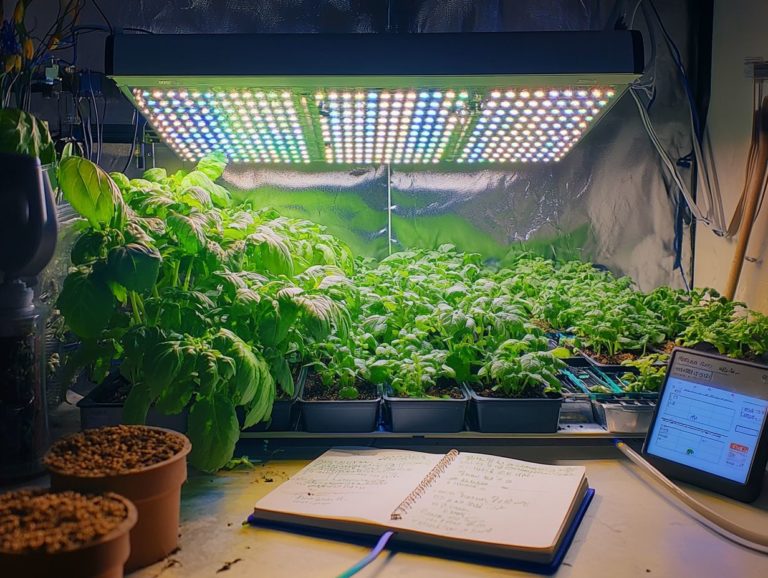Preventing Algae Growth in Hydroponic Systems
At first glance, algae may seem harmless. However, in hydroponic systems, it can seriously threaten plant health and growth, leading to challenges that impact crop yields.
This article explores the causes of algae growth, various factors that encourage its proliferation, and the detrimental effects it can have on your plants, including issues with nutrients and light control.
You ll discover effective prevention methods, best practices for maintaining a vibrant hydroponic environment, and both natural and chemical solutions for controlling algae.
Explore these insights to ensure your hydroponic garden flourishes in a balanced ecosystem!
Contents
- Key Takeaways:
- Causes of Algae Growth
- Effects of Algae on Hydroponic Systems
- Preventing Algae Growth
- Maintaining a Healthy Hydroponic System
- Alternative Solutions for Algae Control
- Frequently Asked Questions
- 1. Why is algae growth a problem in hydroponic systems?
- 2. How can I prevent algae growth in my hydroponic system?
- 3. Is it necessary to completely eliminate all algae in a hydroponic system?
- 4. Can algae growth be harmful to my plants?
- 5. Will using chemicals to prevent algae growth affect my plants?
- 6. Can algae growth be prevented in all types of hydroponic systems?
Key Takeaways:

- Algae growth in hydroponic systems can negatively affect plant health and growth, making prevention crucial.
- Factors such as light, temperature, and nutrient levels contribute to algae growth. Proper maintenance can help control it.
- Effective methods for preventing algae growth include using a UV sterilizer (a device that uses ultraviolet light to eliminate harmful organisms), adding beneficial bacteria, and regularly cleaning the system.
What is Algae and Why is it a Problem?
Algae are simple, photosynthetic organisms that can wreak havoc in hydroponic systems. They can lead to issues like reduced oxygen levels, limited nutrient availability, and stunted crop growth, especially affecting seedlings and plant roots.
Their proliferation often worsens due to poor water quality and nutrient imbalances. It s essential for you, as a hydroponic garden enthusiast, to understand the intricacies of algae growth and its harmful effects.
These organisms come in various forms, from microscopic phytoplankton to larger filamentous varieties, each thriving in nutrient-rich environments. Excessive algae can form a thick layer on the surface of your nutrient solution, obstructing light penetration and hindering the photosynthesis process.
Managing algae growth is crucial for a thriving garden! You should consider using eco-friendly cleaning supplies to keep your systems in check, fostering a healthier environment free from toxic chemicals that could negatively impact your crop yields.
Causes of Algae Growth
Algae growth in hydroponic systems largely depends on a combination of related factors. Excessive light, abundant nutrient availability, and stagnant water conditions create an optimal environment for algae spores to thrive.
By understanding these dynamics, you can take proactive measures to mitigate algae growth and maintain a healthy hydroponic system.
Factors that Contribute to Algae Growth
Several factors can significantly exacerbate algae growth in your hydroponic system. Light exposure, improper ventilation, and nutrient concentrations create an ideal environment for unwanted algae.
These elements interact in intricate ways that can compromise your system’s efficiency. For instance, while excessive light fuels photosynthesis in your aquatic plants, it can also trigger rapid algal blooms if not carefully controlled.
Poor air circulation can lead to stagnant conditions, creating a perfect haven for algae in nutrient-rich environments. An incorrectly balanced nutrient solution can also tip the scale, providing algae with all the essential elements they need to flourish.
Each of these factors is crucial in determining water quality, which directly impacts crop health and overall yield. Therefore, diligent monitoring and adjustment of these variables are vital for maintaining a well-balanced hydroponic ecosystem.
Effects of Algae on Hydroponic Systems

Act fast! The presence of algae in hydroponic systems can lead to significant challenges. It can deplete essential nutrients, cause root rot, and create fierce competition for resources.
Each of these factors can severely hinder optimal crop growth and negatively impact the overall health of your nutrient solution.
Negative Impact on Plant Health and Growth
Algae can significantly disrupt your plants’ health and growth by blocking light from reaching their roots and depleting available nutrients. This can create conditions that may lead to root rot!
Algae forms a dense layer over the soil or water surface, limiting access to sunlight, which is crucial for photosynthesis. Without sufficient light, your plants struggle to generate the energy they need, impacting their overall growth and vitality.
As algae spreads, it competes for vital nutrients in the substrate, leaving less for your crops. Nutrient depletion can seriously slow down your plants’ growth!
Poor drainage from excessive algae can turn your growing environment into a breeding ground for harmful organisms, increasing the risk of root diseases that threaten plant health.
Preventing Algae Growth
To effectively prevent algae growth in your hydroponic systems, adopt a multifaceted approach. This includes managing water quality, maintaining your system regularly, and using high-quality cleaning supplies specifically designed for algae removal.
By doing so, you can maintain a balanced ecosystem that promotes healthy plant growth while keeping algae at bay!
Effective Methods for Controlling Algae
Controlling algae in your hydroponic system can be done through both organic and chemical methods. This includes using hydrogen peroxide, UVC light, and beneficial microbes like Hydroguard, which contains bacillus subtilis. These methods help maintain a balanced ecosystem and reduce algae.
Understanding these approaches is essential for anyone serious about hydroponic gardening. Organic methods, such as introducing beneficial organisms and adjusting nutrient levels, usually create a safer environment for your plants and microbes. Chemical methods like hydrogen peroxide can offer quick relief during heavy infestations, but overusing them can disrupt the delicate balance of your system.
As a hydroponic enthusiast, carefully assess your needs! Implementing UVC light can effectively sterilize your water without harsh chemicals, promoting healthier plant growth, minimizing algae recurrence, and ensuring root disease prevention while maintaining nutrient balance.
Maintaining a Healthy Hydroponic System

To maintain a thriving hydroponic system, consistently monitor environmental conditions, including ventilation and light levels. Using effective algae prevention techniques is equally crucial, ensuring optimal crop growth and preserving your nutrient solution’s health!
Best Practices for Preventing Algae Growth
Preventing algae growth in your hydroponic systems involves several critical steps. Maintain optimal nutrient solutions, ensure adequate ventilation, and regularly inspect your grow pots for any signs of algae infection.
Additionally, minimize light exposure to the nutrient reservoir since algae thrive in bright conditions. Using opaque grow pots can dramatically reduce light penetration, effectively staving off algae growth. For more detailed insights, check out our guide on understanding hydroponic system maintenance.
Monitoring pH levels is essential! Any instability can lead to nutrient inconsistencies that favor algae growth. Regularly cleaning your nutrient system and grow pots will help eliminate organic debris that could become a breeding ground for unwanted growth.
Keep an eye out for any color changes in your nutrient solution; these can be early warning signs! Taking prompt action can safeguard the overall health of your hydroponic garden.
Alternative Solutions for Algae Control
When considering alternatives for algae control in hydroponics, you can explore a range of solutions. Options vary from grapefruit seed extract to Copper Sulphate and Oxine.
Natural options, such as grapefruit seed extract, provide a more organic approach to algae removal. Chemical options like Copper Sulphate and Oxine present their own unique advantages and disadvantages in algae management.
Each solution plays a distinct role in effective algae management. This allows you to tailor your strategy to fit your specific needs.
Natural and Chemical Options
As a hydroponic grower, you have a range of options for algae control. You can choose from natural solutions like Hydroguard and grapefruit seed extract or opt for chemical methods such as UVC light treatment.
If you re leaning towards eco-friendly strategies, natural treatments might catch your eye. Hydroguard utilizes beneficial bacteria, which help break down waste and outcompete harmful organisms.
Grapefruit seed extract is celebrated for its antimicrobial properties. It can effectively inhibit algae growth, but you’ll need to monitor its concentration closely to ensure it doesn t harm your beneficial microorganisms.
On the chemical front, UVC light treatment is a powerful choice. It effectively kills algae by damaging their DNA. However, it requires precise installation and ongoing maintenance to keep things running smoothly in a hydroponic system.
Other specialized chemical solutions may also be effective. Yet, they can carry their own risks, such as toxicity to non-target organisms and potential regulatory concerns.
Striking the right balance between effectiveness and ecological considerations is essential for your optimal algae management strategy. This is particularly important when dealing with water quality and nutrient availability in hydroponics.
Frequently Asked Questions

1. Why is algae growth a problem in hydroponic systems?
Algae growth refers to the rapid reproduction of microscopic aquatic plants. These plants can form a layer on the surface of water, especially affecting plant roots in hydroponic systems.
In hydroponic setups, algae can block pipes and pumps and compete with plants for essential nutrients, leading to decreased yields.
2. How can I prevent algae growth in my hydroponic system?
To prevent algae growth, consider the following methods:
- Using light-blocking materials
- Implementing light control
- Maintaining proper nutrient levels
- Adding natural algaecides like grapefruit seed extract
- Regularly cleaning and sterilizing equipment
3. Is it necessary to completely eliminate all algae in a hydroponic system?
No, it is not necessary to eradicate all algae in a hydroponic system. Some algae can actually be beneficial for plants, providing oxygen and nutrients.
However, excess algae growth should be controlled to prevent potential issues.
4. Can algae growth be harmful to my plants?
Yes, algae growth can harm your plants. It competes with them for essential nutrients and can block the flow of water and nutrients in hydroponic systems.
Some types of algae can release toxins that harm plants.
5. Will using chemicals to prevent algae growth affect my plants?
Using chemicals like Copper Sulphate or Oxine can potentially harm your plants if not used properly. It s important to follow instructions carefully and not exceed recommended doses.
Using natural algaecides or implementing organic methods may be a safer option.
6. Can algae growth be prevented in all types of hydroponic systems?
Yes, algae growth can be prevented in all types of hydroponic systems, including deep water culture and nutrient film technique (NFT).
However, specific preventive measures may vary depending on the type and size of the system.






